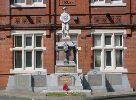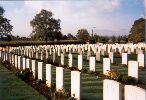
Newton-le-Willows and
Earlestown War Memorial

| OTHER WARS |
 |
Newton-le-Willows andEarlestown War Memorial |
 |
| The
Great War Roll of Honour |
|||||||||||||||||||||||||
Captain H. Whalley-Kelly, in his book “Ich Dien –
The Prince of Wales’s Volunteers”, gives the following account:
“On the Western Front the Allies were advancing from victory to victory,
and in Palestine and Mesopotamia the resistance of the Turks was everywhere
breaking down; the moment was propitious for clearing up the situation in Macedonia
and threatening the flank of the Central Powers. It was decided, therefore,
that the British Salonika Army should attack on 18th September, and that the
French, Serbian and Greek forces should join in the general offensive. The objective
selected by Sir George Milne was the rectangular mass of rugged country bordering
Lake Doiran of which the main features were, on the east, the towering mass
of the Grand Couronne which rose to 1,977 feet and which was about two and a
half miles behind the Bulgarian front line; and, on the west, the famous "Pip"
Ridge. This latter feature, the scene of the battles of 1917, was a bare, razor-backed
spur running gradually upwards from the foremost British trenches, and the lower
slopes were held by our troops and the upper by the enemy.
The " Pip " Ridge was the key to the Vardar-Doiran defences and held
by the best Bulgarian troops. This front was one of exceptional strength, with
concrete machine-gun emplacements and with trenches and trench-mortar pits blasted
out of the solid rock; for three years no artifice had been overlooked to make
the position impregnable, and Nature itself was on the side of the defender,
having provided an intricate and tangled mass of hills and ravines that mount,
tier by tier, to the summit of the Grand Couronne. "P" Ridge, from
a height of over 2,000 feet, dominated our lines and overlooked the country
southward to Salonika, its crest crowned with skilfully sited machine guns firing
in enfilade, and commanding all approaches.
The 66th Brigade was selected to lead the assault on this formidable position,
and the Brigadier decided to advance on a two-battalion front, 12th Cheshires
and 9th Bn. The Prince of Wales's Volunteers, with the 8th King's Own Shropshire
Light Infantry in close support. In the centre, Welsh troops of the 67th Brigade
and the Hellenic Division were to attack the Grand Couronne, and, on the right,
two Greek regiments were detailed to seize Doiran Hill, overlooking the ruins
of the town. Zero was timed for 5.8 a.m. on 18th September.
For four days prior to the attack the Bulgarian positions were bombarded with
great intensity. On the second day of bombardment the Battalion moved forward
to its initial assembly area at the Horseshoe, and on the evening of the 17th
to the jumping-off line; strength, 15 officers and 415 other ranks.
Next morning at zero-hour The Prince of Wales's Volunteers and Cheshires rose
from their starting-line and with great dash carried the first two systems of
trenches at the point of the bayonet. After severe fighting the third system,
on the crest of the ridge, was entered, the troops advancing, in the words of
Sir George Milne's despatch, "with consummate gallantry and self-sacrifice."
The British barrage had now swept on and the enemy, recovering from the first
surprise, poured a devastating machine-gun fire into the ranks of the assailants,
at the same time searching every gully and patch of cover with trench-mortar
shells. Again and again the men were rallied and returned to the assault, but
it proved impossible either to make further progress, or to consolidate the
localities captured in the first rush. Captain L. F. Davidson and Lieutenant
J. Roughley, the latter badly wounded, were particularly prominent in their
efforts to push home the attack, and both were awarded the Military Cross. Sergeants
D. Evans and R. Pownall displayed conspicuous gallantry throughout, and continued
to lead their platoons forward until practically all their men became casualties.
Both these N.C.Os. were awarded the Distinguished Conduct Medal, and eight other
soldiers received the Military Medal.
After several hours of fighting the attackers were eventually compelled to fall
back to our own line. Lieutenant-Colonel B. F. Bishop, M.C., and his Adjutant,
Captain A. D. Trotter, M.C., were both killed while gallantly leading the assault,
and the survivors of the Battalion withdrew to the lower slopes of the fateful
ridge, where, in Jackson's Ravine, they were reorganized by Captain Davidson
and other officers. At nightfall the remnants of the unit marched back to the
Horseshoe and Pillar Hill.
In this heroic attempt to capture the "P" Ridge the Battalion lost
14 officers and 240 other ranks killed, wounded or missing; that is, 65 per
cent. of its strength. The enemy did not escape unscathed, however, and the
heavy casualties he suffered on 18th September, were the beginning of the end
of the Bulgarian resistance.
L. I. Crawford, who served as an officer in the 9th Battalion, and who took
part in the attack on "P" Ridge, in his novel "On the Anvil,"
(published by Ernest Benn, Ltd) describes in vivid language the events of that
morning from the point of view of a platoon commander, and extracts from his
account throw into bold relief some of the vicissitudes suffered by The Prince
of Wales's Volunteers and Cheshires. He says :
"The Pip Ridge, seen from a distance against the sky, resembled a prehistoric
monster, one of those creatures with a sort of hackle of armour plates along
its spine, enormously enlarged. From end to end it was some five miles long,
and the points of the hackles were the five Pips, conical hillocks on the great
parent ridge. The first four Pips, working from the tail of the monster, were
in enemy hands; Pip Five was British, as were the head and neck behind it. To
the right of the ridge as Tim lay, he could see the conical summit of an isolated
mountain; in front of this, and indistinct in the twilight of dawn, came the
tangle of foothills, cut and traversed by a maze of trenches and barbed wire,
which were to be the objectives of the Welsh Brigade and the Greeks. ...
"Tim looked at the luminous dial of his watch; it wanted five minutes to
zero hour, and as he looked the eighteen-pounders opened a blaze of shrapnel
on the position they were to attack first. The minute hand moved inexorably
on; the dim shapes of the Salchesters [Cheshires] gathered themselves to rise.
'Time!' cried somebody, and the Pennines [P.W. Vols.] were on their feet, labouring
up the hill.
"One minute passed, and the laden men panted and swore; the hill was steeper
than even they had anticipated. Two minutes. Three minutes. 'Quicker,' cried
the voice of the Salchesters' colonel, echoing down the hillside. The men increased
the frantic scramble; Tim's lungs seemed about to burst, and red mist gathered
before his eyes. The men beside him were breathing in choking gasps, like wind-sucking
horses. Four minutes! The British barrage stopped abruptly. ...Five minutes!
A minute behind the time-table, and Tim began to see the jagged outlines of
the broken knife-rests against the sky-line above. Six minutes! The British
shrapnel broke out again, dancing far ahead. ...Then the Pennine's poured over
the lip of the crest into the pale light of day. Salchesters and Pennines, utterly
exhausted, flung themselves into the shell holes and blasted earth of the captured
position.
"For a moment there was comparative quiet in the tumbled redoubt; the Bulgars
in the second position were still in doubt as to the fate of the annihilated
garrison. But they soon grasped the situation; a heavy trench mortar shell whirred
ponderously down amongst the recumbent men; then another and another. The officers
drove their gasping command through the smoke of the bursts, and for the first
time British eyes beheld the top of the Pip Ridge, round the flanks of which
they had skirmished so long. ...
" No map, no aeroplane photograph, could have given any idea of the desperate
strength of the place; he himself, who had spent the best part of two years
staring at it through telescopes, had no idea. The crest of the ridge, now black
with advancing Salchesters, was not an easy saddleback a couple of hundred yards
wide, as it appeared in the flattened aeroplane photographs, but a razor-edge,
a mere causeway, above precipitous slopes which seemed to swoop to infinite
depths on either hand. Three hundred yards ahead it widened abruptly, and there
a massive redoubt, crowning the summit of Pip Four, barred it four-square, extending
to the left on a great isolated shoulder of the mountain, which was separated
from the advancing British by a gulf of empty air. ...
"All formation had been lost; the narrowness of the footing had destroyed
the carefully rehearsed battle order, and like a cup-tie crowd the attackers
herded towards the slowly sinking cloud of dust which covered the next objective.
For perhaps a minute nothing opposed them but a desultory rifle fire, and the
splinters from the bursting trench mortar bombs behind, which Tim scarcely noticed.
" Then, as the approaching men became clearly visible to the enemy, there
began a fierce tapping of machine guns all along the front, especially from
the flanking mountain buttress. ...In a few seconds he found himself advancing
alone; the pushing throng of a few moments before were dropping to earth in
half dozens. He stopped in momentary bewilderment. Then his training reasserted
itself. Good God, the attack was falling to pieces! He pressed on impatiently,
crying, 'Come on, Pennines!' ..."
The failure of the attack on "P" Ridge made it impossible to retain
the lower slopes of the Grand Couronne on the right, where the Greek and Welsh
troops, after desperate fighting, had penetrated to a depth of one mile. On
the 19th the attack on "P" Ridge and the Grand Couronne was resumed
with fresh troops. Again the concealed machine guns shattered the advancing
groups of infantry and these vital tactical localities remained in Bulgarian
hands, although a footing was eventually established in the forward system of
the defences, and the ground so dearly won consolidated.
The British offensive had broken down; but the sacrifices were not in vain as
the enemy's reserves had been pinned to this front, and had suffered so severely
in these stubbornly contested operations that they were now ineffective. Largely
as a result, a Franco-Serbian attack west of the Vardar on the 21st succeeded
in turning the Bulgarian flank which caused a hurried retirement from the Doiran
front to commence about noon on that day. The enemy fled along the Strumica
Road, the only good line of retreat now open to him. The Royal Air Force took
full advantage of the targets afforded by the congestion of troops and transport
moving through this defile and over the Kosturino Pass, and by shooting down
men and animals caused confusion which bordered on panic.
On 21st September the Battalion was withdrawn to Le Pacha, where it was reorganized
into two composite companies, Major Rickwood taking over command. On the 23rd,
the Bulgarians having retired along the whole front, the 22nd Division followed
in pursuit with the decimated 66th Infantry Brigade in Divisional reserve; the
immediate trials and tribulations of the gallant survivors were soon over, however,
as Bulgaria sued for peace on the 26th, and on 30th September hostilities with
her ceased."